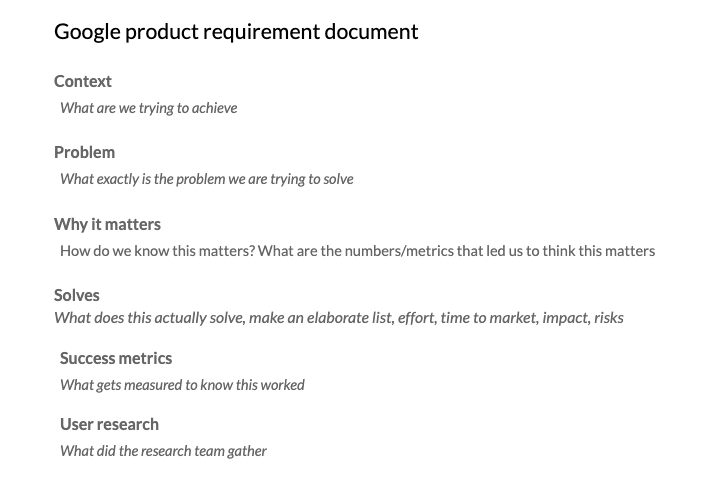The year is 1982, IBM is one of the most innovative companies in the world, and an engineer writes a product requirements document (PRD) before starting the waterfall project that would launch a new feature for an IBM PC.

40 years later, Amazon is one of the most innovative companies in the world, and a product manager writes a PRD during discovery for an agile team to launch a new product iteration on AWS.
Isn’t it weird that so much has changed, but people still use PRDs basically to the same extent? Together with roadmaps, this relic from the past outlived most of the outdated software projects practices for a reason, and that’s what you’ll explore here.
PRDs are so powerful and so important that they’re one of the few common denominators between feature factories and product led companies, market bottom feeders, and top tier tech giants alike. Although there’s no one standard model of what a PRD should look like, the fact that they are so common allows you to track the common denominators among them and reflect on what makes a PRD so effective inside the software industry.
A product requirements document (PRD) has a mostly self explanatory title. At its core, a PRD is a log of what a product concept looks like in terms of scope and objectives. It’s usually under the responsibility of the product manager, but it’s not exclusively limited to the product team. A PRD should be able to be passed around engineering, design, QA, marketing, sales, and C-level without friction.
Despite my opening reflection, PRDs have changed substantially in terms of applicability. If they used to be a set in stone reference document for project management, today they’re living and evolving documents that offer guardrails and accumulated knowledge for tech teams.
To write this article, I’ve researched tens of PRD templates from several different companies (some regarded as highly product-mature, some not so much) and I narrowed down what would be the best possible product requirement document template, or at least the most common one.
Each organization has slightly different reasons to push for a PRD, but almost all of them are valid. As a rule of thumb, a PRD is documentation that can be used during design discussions, stakeholder management or development referencing. It should change as the product discovery and delivery evolve, adapting to reality instead of staying faithful to an original conception that can get outdated pretty quickly.
A lot of criticism that circles around product requirement documents is that they take a lot of time to develop, that they are too lengthy for the standard stakeholder or developer to read, and that because of that they usually get shoved into a drawer during development. It does sound like a waste of time, but it doesn’t have to be. As a matter or fact, PRDs are the backbone of some of the best product companies out there, and this is how they use them.
To help you get started with writing your own PRD, you can follow these five steps:
To Simon Sinek’s delight, his famous business mantra also applies well to PRD writing. Google, Microsoft, Amazon, Figma; it’s very common around the heavy hitters to create requirement documents that open with why that product is required in the first place.
We can easily get fixated with all the writing and documenting that goes into defining the solution, but product requirement documents are also great for strategic backtracking. Five months into development, after your fourth iteration, it’s not unusual that work strays away from its original goal. The fact that you captured the why behind a product inception guarantees you can properly reassess priorities when strategies demand change, or that you won’t lose the value you intended to deliver in the first place.
Don’t shy away from changing this as the product evolves. As the business and technical constraints show up, you not only can, but should, update the motivation behind a product. It’s perfectly reasonable that a product idea dies even before development starts if discovery invalidates its use case.
After the reason why you’re creating your product is well documented, you must establish how you’re going to make sure it can deliver on that objective. Too often, teams deliver something in production only to later find out that they lack the means to measure the full extent of its impact.
You can’t iterate on what you can’t measure. If you’re data-blind, any change is as good as a wild guess, and you can get sidetracked from the original intent. Defining how you can measure impact from your product is also a way to bridge possible delivery with the original goal.
Similar to the “why,” discovery can, and probably will, change how you can best measure the impact of your product.
This is where most PRD templates diverge. Some expect this section to be as exhaustive as possible, while others ask for just a high level overview of features. Some even go a little bit further and get ludic, by simulating a PR letter or FAQ section (looking at you, Amazon).
Whether you’re using one or another template, it’s mostly dependent on your organization’s culture or team preferred practices. Regardless, your solution description should be adequate and comprehensive enough to paint a picture of what the product will look like when done. The PRD is also intended to share information across the organization, so it’s important you make sure you cover all possible interests of your stakeholders.
Writing a PRD for engineers is a completely different task than doing so for the marketing team, or designers, or other product managers. Find who your main audience is and tailor the product description to their interest. Some templates even suggest you write it in different levels of specificity, offering both an exhaustive and bird-eye-view description of what the product is.
Most people hate reading, especially uninteresting documentation. Make sure you can get your message through without spending too much words. A PRD is supposed to be read; there’s no reason why you should transform this experience into an unpleasant one.
An interesting idea that some templates incorporate and that I personally like using myself is using images in your PRD: Prints, mocks, workflows, diagrams… images help you to spend less time describing details and free time for you to cover the more substantial bits of knowledge you might want to record. The same can be said about URL links to external resources such as technical documentation or previous PRDs.
Make sure to keep those images and links up to date. It might be some more work for you to keep pictures and URLs updated as well as text, but I assure you the gain in terms of efficient and effective reading will compensate.
Templates aside, don’t spend so much time finding the ideal format. As long as you make sure that the above points are covered and that whoever reads your documents is satisfied, results speak for themselves and you’re not losing much for using PRD model A or B.
Some teams write PRDs as project epics, others keep a Confluence or Notion page with all relevant information, some use the good old folder and doc system in Office 360 or Google Drive. The format is not even remotely as important as the content and there’s no single best way to create PRDs
The coolest part about PRDs is that they’re one of the few tools of a product-led culture that you can implement without the help of senior management. Even if you’re the only one using it in your entire organization, you’ll be able to get value from it. Worst case scenario, you have a neat document to refer to whenever you need to validate questions and suppositions.
Now that you’re familiar with best practices for PRDs, let’s take a look at how some companies approach creating one. These are likely companies you’re very familiar with, but each takes a slightly different approach:
Google uses a PRD based off of this template here.
On the other hand, Microsoft utilizes a version that you can compare the previous one to:

Product requirements documents have been a staple in the tech industry for decades, surviving the test of time and proving their potential as a tool. From an outdated feature factory to a tier one product-led company, PRDs are a pretty effective way of bridging initial concepts with the final product. The undeniable value that a well-crafted PRD brings to the table is to lay down a common ground across the entire organization, helping everyone from engineers to marketers stay aligned on the product’s goals.
Despite the differences between the plentiful amount of templates available, the key takeaway here should be that PRDs aren’t static documents. They should be center pieces around product development and evolve as discovery and delivery develops. A well written PRD, be it a document, a Confluence page or a Jira epic, is one of the most concrete ways you can crystallize your work and provide value for your team.
Featured image source: IconScout

LogRocket identifies friction points in the user experience so you can make informed decisions about product and design changes that must happen to hit your goals.
With LogRocket, you can understand the scope of the issues affecting your product and prioritize the changes that need to be made. LogRocket simplifies workflows by allowing Engineering, Product, UX, and Design teams to work from the same data as you, eliminating any confusion about what needs to be done.
Get your teams on the same page — try LogRocket today.

A practical five minute revenue estimation method to help product managers compare ideas, drop low impact features, and prioritize smarter.

A practical guide for PMs who want to stop being bottlenecks, delegate smarter, and lead teams effectively with a clear ownership framework.

Stop letting unreliable data block features. Treat data as inventory to track quality, ownership, and ship with confidence.

Learn why slide decks slow teams down and explore better tools like whiteboards, PRDs, and prototypes to improve collaboration and alignment.